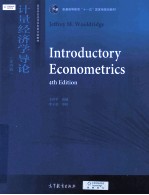

计量经济学导论 第4版PDF格式文档图书下载
- 购买点数:15 点
- 作 者:JeffreyM·Wooldridge 王少平著
- 出 版 社:北京:高等教育出版社
- 出版年份:2014
- ISBN:9787040395945
- 标注页数:481 页
- PDF页数:497 页
Chapter 1 The Nature of Econometrics and Economic Data 1
1.1 What Is Econometrics? 1
1.2 Steps in Empirical Economic Analysis 2
1.3 The Structure of Economic Data 5
1.4 Causality and the Notion of Ceteris Paribus in Econometric Analysis 12
Summary 16
Key Terms 17
Computer Exercises 17
PART 1 Regression Analysis With Cross-Sectional Data 19
Chapter 2 The Simple Regression Model 20
2.1 Definition of the Simple Regression Model 20
2.2 Deriving the Ordinary Least Squares Estimates 25
2.3 Properties of OLS on Any Sample of Data 34
2.4 Units of Measurement and Functional Form 39
2.5 Expected Values and Variances of the OLS Estimators 44
2.6 Regression through the Origin 56
Summary 57
Key Terms 58
Computer Exercises 59
Appendix 2A 61
Chapter 3 Multiple Regression Analysis:Estimation 63
3.1 Motivation for Multiple Regression 63
3.2 Mechanics and Interpretation of Ordinary Least Squares 68
3.3 The Expected Value of the OLS Estimators 80
3.4 The Variance of the OLS Estimators 90
3.5 Efficiency of OLS:The Gauss-Markov Theorem 99
Summary 100
Key Terms 101
Computer Exercises 102
Appendix 3A 105
Chapter 4 Multiple Regression Analysis:Inference 109
4.1 Sampling Distributions of the OLS Estimators 109
4.2 Testing Hypotheses about a Single Population Parameter:The t Test 112
4.3 Confidence Intervals 130
4.4 Testing Hypotheses about a Single Linear Combination of the Parameters 132
4.5 Testing Multiple Linear Restrictions:The F Test 135
4.6 Reporting Regression Results 146
Summary 148
Key Terms 150
Computer Exercises 151
Chapter 5 Multiple Regression Analysis:OLS Asymptotics 154
5.1 Consistency 154
5.2 Asymptotic Normality and Large Sample Inference 159
5.3 Asymptotic Efficiency of OLS 166
Summary 167
Key Terms 168
Computer Exercises 168
Appendix 5A 169
Chapter 6 Multiple Regression Analysis with Qualitative Information:Binary(or Dummy)Variables 171
6.1 Describing Qualitative Information 171
6.2 A Single Dummy Independent Variable 172
6.3 Using Dummy Variables for Multiple Categories 179
6.4 Interactions Involving Dummy Variables 184
6.5 A Binary Dependent Variable:The Linear Probability Model 192
6.6 More on Policy Analysis and Program Evaluation 197
Summary 200
Key Terms 201
Computer Exercises 201
Chapter 7 HeterOskedasticity 207
7.1 Consequences of Heteroskedasticity for OLS 207
7.2 Heteroskedasticity-Robust Inference after OLS Estimation 208
7.3 Testing for Heteroskedasticity 212
7.4 Weighted Least Squares Estimation 218
7.5 The Linear Probability Model Revisited 231
Summary 234
Key Terms 234
Computer Exercises 235
Chapter 8 More on Specification 238
8.1 Functional Form Misspecification 238
Summary 244
Key Terms 244
Computer Exercises 244
PART 2 Regression Analysis with Tine Series Data 245
Chapter 9 Basic Regression Analysis with Time Series Data 246
9.1 The Nature of Time Series Data 246
9.2 Examples of Time Series Regression Models 248
9.3 Finite Sample Properties of OLS under Classical Assumptions 251
9.4 Functional Form,Dummy Variables,and Index Numbers 259
9.5 Trends and Seasonality 266
Summary 276
Key Terrns 277
Computer Exercises 277
Chapter 10 Further Issues in Using OLS with Time Series Data 281
10.1 Stationary and Nonstationary Time Series 281
10.2 Asymptotic Properties of OLS 283
10.3 Using Highly Persistent Time Series in Regression Analysis 289
Summary 296
Key Terms 297
Computer Exercises 297
Chapter 11 Serial Correlation and Heteroskedasticity in Time Series Regressions 302
11.1 Properties of OLS with Serially Correlated Errors 302
11.2 Testing for Serial Correlation 306
11.3 Correcting for Serial Correlation with Strictly Exogenous Regressors 313
11.4 Differencing and Serial Correlation 320
11.5 Serial Correlation-Robust Inference after OLS 322
11.6 Heteroskedasticity in Time Series Regressions 326
Summary 331
Key Terms 331
Computer Exercises 332
PART 3 Advanced Topics 337
Chapter 12 Advanced Panel Data Methods 338
12.1 Fixed Effects Estimation 338
12.2 Random Effects Models 346
12.3 Applying Panel Data Methods to Other Data Structures 351
Summary 353
Key Terms 353
Computer Exercises 354
Appendix 12A 357
Chapter 13 Instrumental Variables Estimation and Two Stage Least Squares 360
13.1 Motivation:Omitted Variables in a Simple Regression Model 361
13.2 IV Estimation of the Multiple Regression Model 371
13.3 Two Stage Least Squares 375
13.4 IV Solutions to Errors-in-Variables Problems 379
13.5 Testing for Endogeneity and Testing Overidentifying Restrictions 381
13.6 2SLS with Heteroskedasticity 385
13.7 Applying 2SLS to Time Series Equations 385
Summary 388
Key Terms 388
Computer Exercises 388
Appendix 13A 392
Chapter 14 Limited Dependent Variable Models 395
14.1 Logit and Probit Models for Binary Response 396
14.2 The Tobit Model for Corner Solution Responses 408
Summary 416
Key Terms 417
Computer Exercises 417
Chapter 15 Advanced Time Series Topics 422
15.1 Infinite Distributed Lag Models 423
15.2 Testing for Unit Roots 429
15.3 Cointegration and Error Correction Models 435
15.4 Forecasting 441
Summary 450
Key Terms 451
Computer Exercises 451
Appendix A The NormaI and Related Distributions 455
Appendix B Answers to Chapter Questions 463
Appendix C Statistical Tables 470
References 477
- 《计量经济学导论 现代观点》(美)J.M.伍德里奇(Jeffrey M. Wooldridge)著;费剑平,林相森译 2003
- 《计量经济学导论》林华德 1978
- 《计量经济学导论》西北大学现代管理研究组编译 1981
- 《计量经济学导论》(英)沃利斯(Wallis,K.F.)著;郑孝齐译 1984
- 《计量经济学导论》王升编著 2006
- 《计量经济学导论 上 第3版》(美)J.M.伍德里奇著;费剑平译 2007
- 《计量经济学导论 下 第3版》(美)J.M.伍德里奇著;费剑平译(密歇根州立大学) 2007
- 《计量经济学导论:现代观点》(美)伍德里奇(Wooldridge,J.M.)著 2004
- 《金融计量经济学导论》(英)克里斯·布鲁克斯(Chris Brooks)著;邹宏元主译 2005
- 《计量经济学导论 现代观点 第3版》(美)伍德里奇(Wooldridge,J.M.)著 2007
- 《计量经济学导论 第4版》JeffreyM·Wooldridge,王少平著 2014
- 《宏观计量的若干前沿理论与应用》王少平著 2003
- 《宏观计量的若干前沿理论与应用》王少平著;李子奈审 2003
- 《计量经济学导论 现代方法 第6版》(美)杰弗里·M.伍德里奇(JeffreyM.Wooldridge)著 2018
- 《计量经济学》王少平,杨继生,欧阳志刚主编 2011
- 《产业共生网络的结构特征研究》王少平,凌岚著 2012
- 《珍奇植物》任海主编;韦强,王少平,林侨生等副主编 2012
- 《夏季养花》王少平,桂育谦主编 2004
- 《海南华侨与东南亚》蔡葩,王少平,王月旺著 2008
- 《电子商务完全手册》恽刚,赵少平著 2000
- 《WEB+DB PRESS中文版 2》日本技术评论社编 2015
- 《THE GOVERNMENT/PRESS CONNECTION PRESS OFFICERS AND THEIR OFFICES》STEPHEN HESS 1984
- 《PRESS》POLITICS & PUBLIC OPINION IN BIHAR 1912-1947 2010
- 《Press law》Robin Callender Smith. 1978
- 《SUING THE PRESS》RODNEY A.SMOLLA 1986
- 《THE PRESS AND AMERICA》 2222
- 《FREEDOM OF THE PRESS》ERIC BARENDT 2009
- 《FREEDOM OF THE PRESS》ROB EDELMAN 2006
- 《FREEDOM OF THE PRESS》DAVID L.GEBERT 2005
- 《Racism and the press》Teun A.van Dijk 2016
